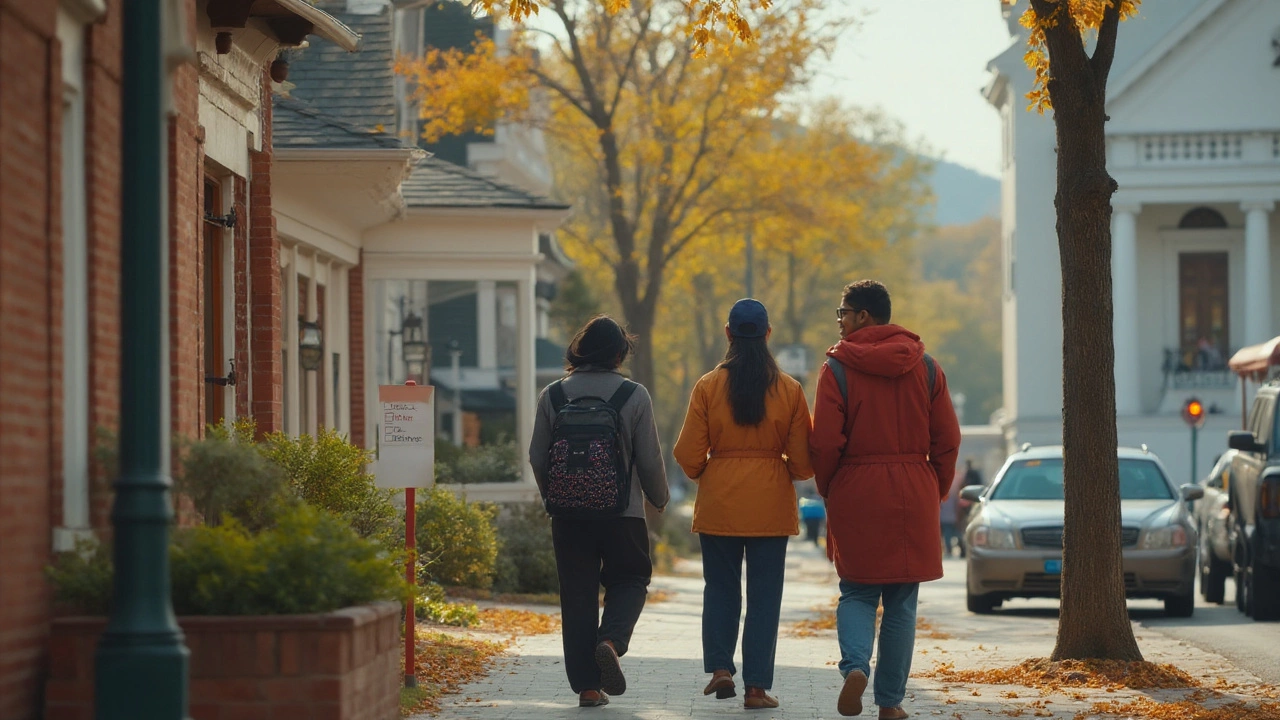If you want the lowest day-to-day costs in Virginia, your compass points away from Northern Virginia and toward Southside and the far Southwest. That’s where rents still slide under four figures, starter homes don’t require a second job, and your grocery bill doesn’t jump at checkout. The trade‑off? Wages run lower, some towns are small and spread out, and you’ll want to double-check internet speeds if you work from home. I’ll help you separate “cheap on paper” from “livable in real life.”
TL;DR
- Cheapest regions: Southside (Danville, Martinsville, South Boston, Emporia), Southwest (Bristol/Abingdon, Norton/Wise, Galax, Wytheville), Alleghany Highlands (Covington), and Shenandoah fringe (Buena Vista, Waynesboro).
- Typical costs: HUD’s FY2025 FMRs put many 2BR rents in these areas around $800-$1,100, versus $1,900+ in Northern Virginia. Entry homes often list in the $120k-$220k range.
- Trade-offs: Lower wages and car‑centric living; healthcare and shopping can mean a longer drive. Fiber internet is improving fast but still patchy.
- Taxes: State income tax up to 5.75%; most areas at 5.3% sales tax; effective property tax rates commonly ~0.6-1.0% (local car tax can surprise newcomers).
- Best fits: Remote workers, budget‑minded renters, first‑time buyers, retirees who value quiet and mountain/outdoor access.
Where Virginia Is Cheapest-and Why These Spots Win
When folks ask me about the cheapest places to live in Virginia, I point to three big zones and a handful of outlier towns. These aren’t up‑and‑coming suburbs; they’re legacy mill, rail, and mountain communities where housing didn’t balloon during the last cycle like it did in Northern Virginia or Charlottesville.
Southside Virginia (U.S. 58 corridor): Danville and Martinsville anchor the list, with South Boston (Halifax County), Emporia (Greensville County), and stretches of Pittsylvania, Henry, and Brunswick counties right behind. HUD’s FY2025 Fair Market Rents and C2ER’s 2024 Cost of Living Index both show this region running well below state averages. Danville’s economy is evolving-advanced manufacturing, logistics, and a resort casino project are shifting demand-but rent and resale listings still land on the low end compared to most of the state.
Southwest Virginia (far west and along I‑81): Washington County (Bristol/Abingdon), the City of Norton/Wise County, Wytheville (Wythe County), Galax with neighboring Carroll/Grayson counties, and stretches of Tazewell, Buchanan, Lee, and Scott tend to be reliably affordable. Think mountain views, small downtowns, and a slower pace. C2ER’s 2024 index places many of these submarkets in the 80s-90s (U.S. average = 100), with housing as the biggest discount driver.
Alleghany Highlands: Covington/Alleghany County sit west of I‑64 in a pocket where home prices and rents are among the state’s lowest. After industrial changes, housing supply outpaced demand for years. That’s kept mortgage payments and rents gentle, though job options are narrower.
Shenandoah fringe (budget‑friendlier pockets): Waynesboro, Buena Vista, and parts of Augusta and Rockbridge counties are usually cheaper than popular neighbors like Charlottesville or Harrisonburg. Not the absolute floor statewide, but great value if you want mountains plus more services than ultra‑rural counties offer.
Standout cheap towns and small cities to put on your map:
- Danville & Pittsylvania County: One of the best renter values, with many 2BRs posting under $1,000 according to FY2025 FMRs and local listing medians. Industrial recruitment and the casino project add jobs; prices are rising from a low base, so move fast if you find a good unit.
- Martinsville & Henry County: Big housing bang for your buck, plus quick access to trails and Philpott Lake. The economy is diversifying from furniture/textiles to logistics and light manufacturing.
- Bristol/Abingdon (Washington County): Scenic and livable, with better dining than you’d expect for the size. Rents and home prices are higher than Danville/Martinsville but still budget‑friendly by Virginia standards.
- Norton & Wise County: Among the state’s lowest home prices. Very small, very mountain. If remote work is your plan and you like quiet, it deserves a look.
- Covington & Alleghany County: Often the cheapest line items for both buyers and renters; verify job fit and commute before you commit.
- Galax, Carroll & Grayson: Bluegrass heritage, hills for days, and rental listings that don’t punch the wallet. Limited apartments; small multiplexes and single‑family rentals are common.
- Emporia & Greensville/Brunswick: I‑95/I‑85 crossroads. Cheaper housing, simple living. Good if you travel the corridor.
- Waynesboro & Buena Vista: Not rock‑bottom prices, but fair housing costs, mountain access, and reasonable drives to bigger job centers like Staunton, Charlottesville, or Lexington.
Credibility note: The shortlists and ranges here draw on HUD FY2025 Fair Market Rents, the U.S. Census Bureau’s 2023 American Community Survey, the C2ER Cost of Living Index (2024), and on‑the‑ground scans of recent listing medians. If you’re comparing to a higher‑cost area like Arlington or Fairfax, the gap is stark.
What It Really Costs: Housing, Taxes, Utilities, Insurance, Groceries
Sticker prices don’t equal living costs. Here’s what you’ll actually pay, in practical ranges, with trade‑offs baked in.
Rent: In Southside and much of the far Southwest, HUD’s FY2025 FMRs peg 2BR baselines in the ballpark of $800-$1,100. One‑bedrooms often land in the $650-$900 band. Private listings can beat or exceed those numbers depending on neighborhood, unit quality, and whether utilities are included. For comparison, 2BRs in Northern Virginia typically start around $1,900 and shoot past $2,400 in many buildings.
Buying a home: Entry‑level single‑family homes and townhomes in these cheapest regions often list between $120k and $220k. Small, dated, but livable places can show under $100k, especially in Norton, Covington, or parts of Henry and Carroll counties. Use a 28/36 rule of thumb: keep your mortgage (PITI) under 28% of gross income, and all debts under 36%. On a $180k purchase with 5% down at a mid‑6% rate, you’re roughly in the $1,200-$1,350 PITI zone, depending on taxes and insurance.
Property taxes: Virginia’s effective property tax rates are low‑to‑moderate by national standards-commonly ~0.6-1.0%, and often lower in rural counties. Check the county/city rate and any service district add‑ons. One big Virginia quirk: many localities charge a personal property tax on vehicles. That “car tax” can be a few hundred dollars annually on a typical used car, more for newer models. Ask the local commissioner of the revenue to estimate it; build it into your budget.
Utilities (electric, heat, water): Expect electric bills to do the heavy lifting since heat pumps are common and natural gas lines are sparse outside bigger towns. For a small apartment or modest home, $120-$180/month for electricity is a fair planning range; add more for poorly insulated older homes or deep‑cold snaps. Water/sewer in small cities runs roughly $40-$80/month for a household of two. If a home runs on propane, remember you’ll pay in larger deliveries-budget seasonally.
Internet: The Virginia Telecommunications Initiative (VATI) has helped push fiber into a lot of rural pockets, but coverage is still uneven. You’ll find fiber in slices of Danville, Martinsville, Bristol/Abingdon, and along newer co‑op lines; other streets are still on cable or fixed‑wireless. Budget $55-$90 for broadband. If your income depends on Zoom calls, verify the address on a provider’s availability map before you sign a lease.
Transportation: You’ll drive more. Gas is similar statewide, but the real costs are depreciation and miles. A simple commute math trick: $0.65 per mile captures fuel, tires, and wear. A 40‑mile round trip, five days a week, is about $520/month. Car insurance is usually cheaper than in Northern Virginia; $70-$130/month is a reasonable range for a clean record in these regions, but quotes swing with age, vehicle, and credit. Don’t forget that local car tax.
Groceries and sales tax: Most of Virginia sits at a 5.3% combined state/local sales tax; some regions (NOVA, Hampton Roads, Historic Triangle) add regional surtaxes. Southside and Southwest grocery tabs tend to be slightly lower than urban cores, though name‑brand prices won’t be night‑and‑day different. You’ll save more by shopping regional chains, farmers markets, and discount grocers than by changing counties.
Childcare and healthcare: Daycare rates in these cheapest regions can be half or even a third of NOVA prices, but supply is thin-waitlists are common. Hospital access is decent near Danville (Sovah Health), Bristol/Abingdon (Ballad), and Wytheville; more remote counties mean longer drives and fewer specialists. If you need frequent care, map drive times before you move.
Sources for the ranges above: HUD FY2025 Fair Market Rents (for rent baselines), U.S. Census ACS 2023 (incomes, housing characteristics), C2ER 2024 (COL differentials), Virginia Department of Taxation and locality budget documents (tax rates), plus current utility and ISP schedules where available.

Pick by Lifestyle: Best Cheap Spots for Different Needs
Not everyone hunts the absolute lowest rent. You might want a little music scene, fiber internet, or a gentler school commute. Here’s how I’d match places to real‑world lifestyles.
- Lowest rent, quickest move‑in: Danville, Martinsville, Covington, Galax, Norton. Why: steady inventory at modest prices; landlords used to working with first‑timers; plenty of small multiplexes and single‑family rentals. Watch for older HVAC and insulation-utility bills can erase a cheap rent.
- Best for first‑time buyers under $250k: Pittsylvania, Henry, Wythe, Washington (outside Abingdon’s pricier streets), Alleghany, and parts of Carroll/Grayson. Most of these zip codes qualify for USDA Rural Development loans (zero‑down if you fit income/house rules). Virginia Housing also has first‑time buyer programs-ask a lender who writes in these counties.
- Remote workers who want fiber and coffee: Abingdon/Bristol, Waynesboro, Pulaski, Wytheville, and parts of Danville/Martinsville have growing fiber footprints and decent cafés. You get mountain weekends without Northern Virginia rent.
- Families who want a slower pace but decent services: Waynesboro (close to Staunton and Augusta amenities), Abingdon (Washington County schools), Rocky Mount/Franklin County (value near Smith Mountain Lake), and parts of Bedford County (near Lynchburg) strike a nice balance of affordability and access.
- Outdoors first, everything else second: Galax/Grayson (New River, Grayson Highlands), Wise County (High Knob), Washington County (Appalachian Trail access) make weekend adventures a Tuesday‑night thing.
- Commuters to job hubs: If you work in Roanoke or Blacksburg, look at Salem and Vinton for closer‑in value; Pulaski and Radford stretch your dollar more but watch student‑driven rent spikes in fall.
Where not to look if your budget is tight: Arlington/Alexandria/Fairfax (Northern Virginia), the core of Charlottesville/Albemarle, parts of Williamsburg/James City County, and much of Virginia Beach/Chesapeake are simply on a different price tier. Roanoke and Richmond are affordable compared to NOVA, but they’re pricier than Southside/Southwest.
Safety and schools, quickly: Even the cheapest cities have blocks you’ll love and blocks you’ll avoid. Pull Virginia State Police’s “Crime in Virginia” reports to compare cities, and check school quality via state report cards. Then go walk the neighborhoods at dusk. You’ll learn more in 15 minutes on foot than in 15 hours online.
Your Shortcut Plan: Budget, Verify, Visit, Decide
Here’s the playbook I give friends so they don’t fall for a too‑good‑to‑be‑true listing.
- Set a hard monthly number. Use 30% of gross income as a rent cap. If you’re buying, cap PITI at 28% and total debts at 36%. Keep a cushion for car tax, internet, and winter electric spikes.
- Estimate commute and life logistics. Use $0.65/mile to cost out driving. Check hospital distance, daycare waitlists, and the nearest grocery that you’d actually shop.
- Verify internet at the address level. Don’t assume fiber because the town has it. Check the provider’s map or call with the exact address. Ask the landlord for the ONT or coax drop location in the unit.
- Call utilities before you tour. Ask for average electric usage for the last 12 months at that address (some utilities will share a range). Old windows and baseboard heat can turn a $750 rent into a $1,000 reality in January.
- Check taxes with the locals. Call the commissioner of the revenue for two quotes: real estate tax on a $200k home in your target neighborhood, and personal property tax on your car’s assessed value. No surprises later.
- Use the flood and fire risk map. Look up FEMA flood zones and ask your insurance agent to quote the address. A “cheap” house in a floodplain can cost more monthly than a slightly pricier one uphill.
- Tour at real‑life hours. Visit around school pickup, shift changes, and late evening. Listen for highway hum and train horns; check cell reception and water pressure.
- Talk to three locals. Barista, neighbor on a porch, clerk at the hardware store. Ask where they’d live on your budget and why. People are blunt and generous with the truth.
Quick checklist you can copy:
- Budget set: $____/month rent OR max PITI $____
- Commute miles: ____ x $0.65 = $____/month
- Internet confirmed at address: Provider ____ / Speed ____
- Electric average last 12 months: $____ (ask utility/landlord)
- Real estate tax on target price: $____/year
- Car tax estimate: $____/year
- Flood zone/insurance: Y/N and $____/year
- Daycare/waitlist notes: ____
- Hospital/urgent care drive time: ____ minutes
- Walk‑through at night done: Y/N
Pro tips:
- Ask landlords for heat type. Heat pumps are fine; older baseboard or space heaters often mean higher bills.
- If you see brand‑new flooring and fresh paint in a very old house, check the crawlspace and attic for insulation. Pretty isn’t the same as efficient.
- In small markets, a good agent is leverage. They know which blocks have chronic drainage issues or laggy internet-even when the listing looks perfect.

FAQ and Your Next Moves
What part of Virginia is cheapest to live in? Southside and the far Southwest. Cities like Danville, Martinsville, Norton, Covington, and towns around Galax, Wytheville, and Bristol/Abingdon typically post the lowest housing costs. Alleghany Highlands (Covington) is often at the bottom for both rents and home prices. That’s the headline answer.
What specific city is the absolute cheapest? It changes listing by listing. Covington, Norton, and pockets of Henry, Carroll, and Buchanan counties consistently show the lowest asking prices. Danville and Martinsville usually offer the best mix of low rent plus services and jobs.
Is Roanoke cheap? Cheaper than Northern Virginia, yes; but pricier than Danville or Wise County. Roanoke’s value is balance-jobs, hospitals, greenways, and good food-without NOVA prices. If you’re squeezed at $1,200/month, Southside or the far Southwest will stretch your dollar more.
Is Virginia Beach cheap? Not in the sense we’re using here. You can find deals, but averages in Virginia Beach/Chesapeake/Norfolk run higher than Southside/Southwest for both rent and purchase.
Will the casino in Danville make it expensive? It’s already nudging rents up around new jobs and hospitality. But compared to Richmond or NOVA, Danville still sits in the “affordable” lane. If Danville is your pick, start the search early and be ready with application docs.
What about safety? It’s block‑by‑block. Pull Virginia State Police “Crime in Virginia” city reports, then go walk the streets you’re considering at different times. Talk to neighbors. You’ll get a clearer read than from broad crime maps.
How’s broadband in the cheap areas? Better every quarter, uneven street to street. Southside co‑ops and municipal initiatives put fiber on a lot of poles; parts of Abingdon/Bristol and Waynesboro are strong. Always verify by address before you sign a lease.
Any hidden costs? The local car tax catches newcomers. Also budget for higher winter electric bills in older homes, and add miles to your monthly costs if you’ll drive for groceries or daycare. Insurance can jump if your address is far from a fire station-ask your agent for a quick quote.
Are there grants or loans to help? Yes. USDA Rural Development loans cover many of these ZIPs with zero‑down options if you qualify. Virginia Housing offers down payment assistance and first‑time buyer programs. Local housing nonprofits in Danville, Martinsville, and Bristol also run periodic aid programs-ask around.
What’s the job market like? Smaller and more specialized than big metros. You’ll see opportunities in advanced manufacturing, logistics, healthcare, education, and hospitality/tourism. If your work is remote‑friendly, you’ll enjoy the cost savings most.
Okay, I’m ready-what are my next steps?
- Shortlist three places: one Southside (Danville/Martinsville), one Southwest (Abingdon/Bristol or Wytheville), one Alleghany/Shenandoah fringe (Covington or Waynesboro).
- Run the checklist (internet, utilities, taxes, commute). Cross off the one that fails on two or more items.
- For renting: gather pay stubs, ID, references, and deposit funds now. For buying: get a pre‑approval from a lender with recent loans in your target counties.
- Book a two‑day scouting trip. Spend day one touring neighborhoods and essentials (groceries, daycare, hospitals). Day two is for showings and talking to locals.
- Decide with numbers, not vibes. Compare total monthly costs line‑by‑line, including car tax and internet. Pick the place that leaves a cushion.
If you came here for the straight answer, it’s this: Virginia’s cheapest living is in Southside and the far Southwest-Danville, Martinsville, Norton, Covington, Galax, Wytheville, Bristol/Abingdon, and their surrounding counties. The wins are real: lower rent, doable mortgages, quieter streets. Just be smart about the fine print-verify internet, price the commute, and check that car tax-so the low sticker price stays low after you move your couch in.





